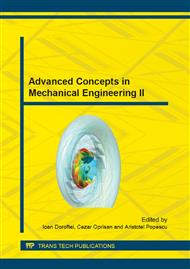[1]
W. Pawlus, H. Reza, K.G. Robbersmyr, Development of lumped-parameter mathematical models for a vehicle localized impact, Journal of Mechanical Science and Technology 25 (7) (2011), 1737-1747.
DOI: 10.1007/s12206-011-0505-x
Google Scholar
[2]
P. Du Bois, C. Chou, B. Fileta, T. Khalil, A. King, H. Mahmood, H., Mertz, J. Wismans, Vehicle Crashworthiness and Occupant Protection, American Iron and Steel Institute, 2000 Town Center Southfield, Michigan, (2004).
Google Scholar
[3]
S. Tabacu, Modele pentru studiul impactului frontal si lateral la automobile de fabricatie romaneasca, Doctoral thesis, (2002).
Google Scholar
[4]
L. Sunghak et al., Effect of Troggering on the energy absorbtion capacity of axial compressed aluminium tubes, Materials and design, 20 (1999), 31-40.
Google Scholar
[5]
J. Marsolek, H.G. Reimerdes, Energy absorption of metallic cylindrical shells with induced non axysimmetric folding patterns, International Journal of Impact Engineering, 30, (2004), 1209-1223.
DOI: 10.1016/j.ijimpeng.2004.06.006
Google Scholar
[6]
D. Dimas, A. Alves, N. Peixinho, D. Soares, C. Vilarinho, Configurable thermal induced triggers for crashworthiness application, Proceedings of conference SMART' 09- Smart Structures and Materials, Porto, Portugal, Julho de (2009).
Google Scholar
[7]
Kee Poong, Kim, Hoon, Huh, Dynamic limit analysis formulation for impact simulation of structural members, International Journal of Solids and Structures 43, (2006), 6488-6501.
DOI: 10.1016/j.ijsolstr.2005.12.004
Google Scholar
[8]
Anthony K. Picketta, Thomas Pyttelb, Fabrice Payenb, Franck Lauroc, Nikica Petrinicd, Heinz Wernere, Jens Christlein, Failure prediction for advanced crashworthiness of transportation vehicles, International Journal of Impact Engineering 30, (2004).
Google Scholar
[9]
P. Jonsén, E. Isaksson, K.G. Sundin, M. Oldenburg, Identification of lumped parameter automotive crash models for bumper system development, International Journal of Crashworthiness, 14: 6, (2009), 533 - 541.
DOI: 10.1080/13588260902837262
Google Scholar
[10]
M. Polhak, J. Majak, M. Eerme, Optimization of car frontal protection system, Int. J. Simulation Multidisciplinary Design Optim., (2007), 1, 31–37.
DOI: 10.1051/ijsmdo:2007004
Google Scholar
[11]
R. Gaiginschi, I. Filip, Technical expertise of road accidents, Editura Tehnica, (2002).
Google Scholar
[12]
A. Soica, N. Ispas, Establishing the Stiffness Coefficient of a Structure by Aproximating the Deceleration Curve with Polinomial Laws of Various Degrees, Proceedings extended abstracts of the annul session of scientific papers IMT Oradea-(2012).
Google Scholar
[13]
A. Soica, N. Gh. Radu, The Influence Of Triggers Geometry Upon The Stiffness Of Cylindrical Thin Walled Tubes, Central European Journal of Engineering, Print ISSN 1896-154, (2013), Springer, DOI 10. 2478/s13531-013-0125-6.
DOI: 10.2478/s13531-013-0125-6
Google Scholar


